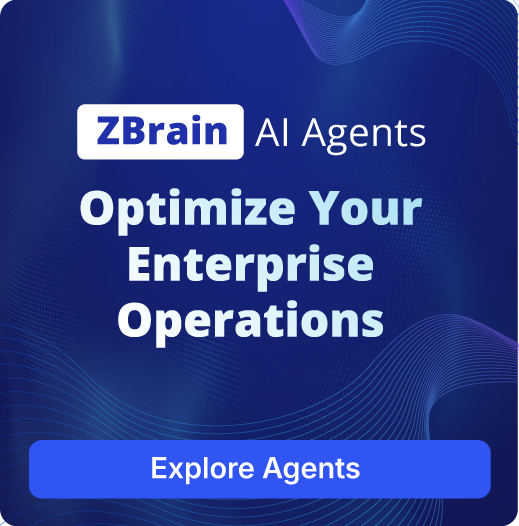Enterprise search and discovery with ZBrain: The graph RAG approach

Listen to the article
Enterprise data has expanded in volume and complexity, encompassing a wide range of formats, including unstructured documents, databases, emails, and other digital assets. Traditional enterprise search systems, which rely on simple keyword matching, have struggled to keep pace with this growth. Keyword-based search often returns a barrage of results without understanding context or intent – users must craft exact terms and sift through many irrelevant hits. In fact, these older approaches primarily rely on literal keyword matching and often fail to capture the meaning behind queries, resulting in shallow results that fall short of expectations.
Modern AI-driven techniques address these shortcomings by moving beyond keywords to semantic understanding. Using natural language processing (NLP), modern enterprise search interprets the meaning of queries and content. Techniques like semantic search represent text as high-dimensional vectors (embeddings) that capture conceptual meaning, enabling the system to find relevant information even if the exact keywords differ. This yields far more context-aware results – the search can recognize synonyms, related concepts, and the broader intent behind a query. Moreover, as enterprise knowledge repositories are updated continuously, modern search solutions can incorporate real-time information, rather than being limited to a static index. The result is a more intelligent discovery experience that surfaces precise answers and actionable insights, rather than a mere list of loosely matching results.
At the same time, Retrieval-Augmented Generation (RAG) has emerged as a particularly powerful approach to modern enterprise search. RAG combines search with generative AI, so instead of just listing documents, the system can generate a direct answer or summary based on retrieved context. This method ensures that even with massive data stores, users receive contextually relevant and up-to-date answers. By grounding generative models in enterprise data, RAG-based search addresses the limitations of keyword search, incorporating domain-specific knowledge, understanding complex queries, and providing the reasoning or sources behind answers. The evolution from basic keyword search to RAG-driven semantic search marks a leap in enterprise knowledge discovery capabilities, aligning results with the user’s true information need rather than mere text matches.
ZBrain presents itself as a unified platform for end-to-end AI enablement, featuring a modular architecture that facilitates the development of custom AI solutions tailored to your organization’s specific needs. At the heart of its intelligent search capabilities is graph RAG—a Retrieval-Augmented Generation approach that combines:
- Knowledge graph storage models (nodes and edges) to capture and traverse semantic relationships in your data
- Vector databases for fast similarity searches over high-dimensional embeddings
- Semantic search to interpret user intent and surface the most relevant information
By combining the strengths of graph-based retrieval and generative models, ZBrain provides a search and discovery experience that surpasses keyword matching and flat vector lookups, enabling deeper insights and more precise answers than traditional methods.
Understanding the RAG approach in ZBrain
Retrieval-Augmented Generation (RAG) is an advanced NLP technique that fuses a search component with a generative AI model. At its core, RAG enhances large language models (LLMs) by incorporating an external knowledge retrieval step, thereby overcoming the limitations in knowledge and context that standalone LLMs face. RAG combines both retrieval and generation elements to enhance the capabilities of AI language models. It addresses the fact that pre-trained LLMs possess static knowledge and can generate incorrect answers through hallucination.
In a RAG pipeline, the process begins with retrieval, which involves searching enterprise knowledge sources for relevant information in response to a user’s query. Relevant information is retrieved from enterprise repositories, document stores, intranets, or other sources by applying dense embeddings and similarity search. The retrieved context is then used by an LLM to generate a final answer grounded in real data. By combining these steps, RAG effectively gives the model a “non-parametric memory” — access to external knowledge on the fly — supplementing its built-in (parametric) knowledge. This means that instead of relying only on what it learned during training (its fixed or ‘parametric’ memory), the model can also search for and use up-to-date data (its ‘non‑parametric memory’) whenever needed. This makes its answers more accurate and current.
The result is:
-
Accurate and current responses: Responses are grounded in the most recent data retrieved from the knowledge base, rather than relying only on the model’s static training.
-
Domain-specific precision: The system retrieves and uses company-specific policies, reports etc. to ensure answers align with your unique context.
-
Minimized hallucinations: By grounding generative output in real, retrieved source text, the risk of fabricated or unverifiable content is significantly reduced.
ZBrain’s graph-powered RAG
ZBrain takes conventional RAG a step further by combining graph-based retrieval with vector similarity and generative models, which we refer to as graph RAG. Key capabilities include:
-
Automatic, semantic chunking
ZBrain’s default “Automatic” mode transforms raw content into semantically meaningful snippets—no manual rules required. Here’s how it works:
-
Embedding-driven splits
ZBrain uses dedicated embedding models to represent sentences and paragraphs as high-dimensional vectors. -
Conceptual coherence
Rather than cutting at fixed token counts, ZBrain measures cosine similarity between adjacent sentence embeddings. It merges text until a semantic boundary is reached, so each chunk contains a single, coherent idea (for example, a complete paragraph, a bullet list, or a thematic block). -
Configurable thresholds under the hood
The platform applies default settings for maximum chunk size and overlap (visible in the “Automatic Chunk Settings” panel) to ensure every snippet fits within LLM context windows while preserving context at boundaries.
The result is a set of self-contained, context-rich nodes, ready for graph construction and retrieval, which deliver highly accurate, efficient, and meaningful search results than naive fixed-length splitting.
-
Custom chunking for specialized documents
For documents with intricate structure, such as legal contracts, policy manuals, or technical specifications, ZBrain lets you tailor chunking rules to preserve meaning and context:
-
Rule-based splits
Define explicit markers (headings, numbered sections, clause identifiers) so chunks align with natural document boundaries, rather than slicing mid-sentence or across unrelated topics. -
Token-length constraints
Enforce a maximum token count per chunk to ensure compatibility with any LLM’s context window, automatically spilling overflow into the next logically linked segment. -
Split-protection zones
Specify regions (e.g., tables, code blocks, footnotes) where chunking must be suppressed, keeping those elements intact for coherent downstream processing. -
Live preview & iteration
Instantly preview how rules apply across sample documents, tweak thresholds or markers, and validate that each chunk remains both self-contained and semantically focused before committing.
By combining structural cues with token limits and protected regions, ZBrain’s custom chunking ensures that every node in your knowledge graph is a clean, contextually rich unit, maximizing retrieval relevance and generative accuracy for even the most demanding enterprise content.
-
Vector store and retrieval in ZBrain
ZBrain’s vector store and retrieval settings empower your AI applications with high-performance similarity search while giving you flexibility and cost control.
-
Vector store options
-
Economical (Built-in)
-
Leverages ZBrain’s native vector engines alongside keyword indexes.
-
Optimized for cost-efficiency at enterprise scale, without sacrificing query speed or accuracy.
-
-
Pinecone integration
-
Seamlessly connects to your Pinecone instance for even greater scalability.
-
Offloads indexing and retrieval to Pinecone’s managed service, benefiting from its global infrastructure and advanced vector algorithms.
-
-
-
Retrieval settings
Within your chosen vector store, you can configure how ZBrain finds and ranks relevant chunks:
|
Setting |
Description |
|---|---|
|
Vector Search |
Recommended default. Performs k-nearest neighbor lookups over embeddings to surface the Top K most similar chunks. |
|
Choose how many results (e.g., 10-200) to retrieve per query, balancing precision versus recall. |
|
Optionally filter out anything with a similarity score below a cutoff, thereby tightening relevance at the expense of coverage. |
|
Full-text Search |
Index all words in every chunk for traditional keyword search—useful when exact term matching is paramount. |
|
Hybrid Search |
Runs vector and full-text in parallel, then re-ranks combined results via a custom reranker model—delivering the best of both worlds. |
-
Embedding model selection
-
Drop-down list: Pick from a suite of pre-configured encoders (e.g., text-embedding-3-large, domain-tuned variants).
-
Impact on retrieval:
-
Larger or domain-specific models yield richer semantic representations (with better accuracy) but incur higher computational costs.
-
Smaller models run faster and more cost-effectively, making them suitable for less complex content or high-throughput scenarios.
-
-
-
Knowledge graph RAG path
Within Data Refinement Tuning, you can select Knowledge Graph as your RAG definition. ZBrain translates each semantically chunked segment into a graph node, with extracted entity or structural links forming edges, laying the foundation for rich, interconnected semantic retrieval.
Retrieval modes and their uses
After selecting the graph, ZBrain offers four modes to guide how queries traverse and retrieve information:
|
Retrieval Mode |
Purpose & Behavior |
Ideal Use Cases |
|---|---|---|
|
Local Mode |
Focuses on specific entity context using low-level keywords and graph proximity. Retrieves direct, entity-centric snippets. |
Q&A about a particular policy, product feature, or isolated technical detail. |
|
Global Mode |
Emphasizes relationship-based knowledge, traversing edges to reveal broader concept interconnections. |
Holistic questions that require networked insights—e.g., “How do X, Y, and Z relate?” |
|
Hybrid Mode |
Combines both: runs local and global retrieval, then merges results. |
Complex business questions need both entity facts and contextual relationships. |
|
Mix Mode |
Executes both vector (semantic) and graph retrieval in parallel, drawing from unstructured and structured data, including time metadata. |
Multi-dimensional queries—like trend analysis or compliance review—where both granular and broad temporal context matter. |
Why knowledge graph retrieval matters
-
Multi-hop reasoning: Unlike flat vector RAG, graph traversal enables answers drawn from multi-step relationships—ideal for logical or lineage queries.
-
Context and explainability: Delivers not just text, but path-based evidence, making outcomes traceable and auditable.
-
Semantic integration: Entities and their semantically labeled edges offer a richer understanding than keyword indexing alone.
-
Hybrid RAG superiority: Mixing graph and vector pipelines offers greater accuracy than either alone, especially for high-stakes enterprise domains.
Back-end configuration and controls
-
Top K and score threshold: Fine-tune the number of retrieved nodes and enforce relevance cutoffs.
-
Embedding models: Use the drop-down to select an encoder tailored to your domain—stronger embeddings = better entity matching.
-
Keyword indexes and hybrid: For Mix or Hybrid Modes, the system combines a semantic embedding match with a lexical full-text search, before applying custom rerankers for precision.
ZBrain’s RAG tech stack
|
Component |
Technology |
|---|---|
|
Language |
Python, JavaScript |
|
Library |
LightRAG, Cytoscape |
|
Frameworks |
FastAPI (Python), Express (Node.js) |
|
Message Queue |
RabbitMQ |
|
Cloud Provider |
AWS |
|
Database |
MongoDB |
|
File Store |
AWS S3 |
|
VectorDB |
NanoVectorDB |
|
GraphDB |
NetworkXStorage |
By embedding graph-centric RAG within its modular AI architecture, ZBrain delivers search and discovery that is context-aware, trustworthy, and continuously current, empowering leaders to act on the right information at the right time.
Streamline your operational workflows with ZBrain AI agents designed to address enterprise challenges.
ZBrain’s graph RAG: Enabling smarter, more reliable knowledge retrieval
Graph RAG is a next-generation RAG architecture that builds and leverages an explicit knowledge graph of the document corpus. Rather than relying solely on flat vector similarity, graph RAG extracts entities and relationships from the data to create a structured graph. During indexing, each document is broken into analyzable units, entities and their relations are identified, and the graph is hierarchically clustered into “communities.” These communities are then summarized (often via an LLM), providing a top-down view of the data. The figure below illustrates this concept: the graph’s colored nodes represent entities and edges their relationships, grouped into clusters (communities).
Graph RAG’s modular pipeline mirrors RAG stages but is centered on the graph:
-
Indexing (Graph construction): Identifies entities and relations, and builds the graph. Clusters nodes into communities, and generates a summary text for each cluster. This creates a multi-level representation of the corpus, capturing both fine-grained facts and high-level themes.
-
Retrieval (Graph search): Instead of just vector lookup, a query is answered by graph operations. This may involve entity linking (mapping query terms to graph nodes) and then exploring the graph structure to fetch relevant nodes or subgraphs. Because the graph encodes semantic connections, graph RAG can “connect the dots” across disparate facts—a task that simple vector RAG often fails to accomplish.
-
Context injection and prompting: The retrieved subgraph (or its community summary) is fed into the LLM’s prompt. Graph RAG often uses the community summaries as context for broad, holistic questions, or the neighboring nodes (with linked text) for targeted entity questions. In effect, the graph guides which pieces of knowledge to present to the LLM. A final prompt-tuning step can further optimize the use of graph-derived context.
Retrieval mechanism and efficiency
Graph RAG’s retrieval phase is inherently graph-structured, which solves many retrieval challenges “out of the box.” For instance, answering a multi-hop query (e.g., “How is Person A connected to Company B?”) involves traversing the graph edges from A to B, rather than relying on a single text passage to contain both facts. In practice, graph RAG implements multiple query modes, such as:
-
Global search: Utilizes a community summary to address comprehensive questions about the entire dataset. The LLM sees a concise synopsis of each cluster, enabling it to reason at a high level without needing to read all documents.
-
Local search: Starts from a specific entity node (from the query) and “fans out” to its neighbors in the graph. This gathers closely related facts and definitions around the target entity.
-
Hybrid (DRIFT) search: Performs a local entity search while also including a relevant community summary. This combines the precision of local facts with the broader context of the community summary, helping the LLM ground details in the larger narrative.
These graph search modes automatically adapt to query complexity: broad exploratory questions trigger the global mode (with fewer nodes and higher summaries), while narrow factoid queries utilize the local mode. Because the graph encodes explicit relationships, even when the query language doesn’t exactly match the text, the system can still find the relevant connections.
In terms of efficiency, graph RAG can be surprisingly economical. By condensing large document clusters into concise summaries and retrieving only the most relevant nodes, the LLM needs far fewer tokens to form an answer. In fact, Microsoft reports that GraphRAG often uses 26–97% fewer tokens than conventional RAG methods. This cuts inference cost and keeps latency low. Meanwhile, AWS reports show that adding graph structure has been shown to boost answer accuracy by over 35% compared to vector-only RAG. In short, the knowledge graph acts as a powerful filter and router, delivering richer, more relevant context with minimal overhead.
Integration with generation and enterprise use
Once the graph retrieval step selects the relevant knowledge, that information is injected into the LLM’s prompt to condition its output. Graph RAG typically presents a mix of raw text (from nodes) and higher-level summaries to the model. For example, community summaries provide background (“Person A is known for…”), while local node text supplies specific details (“Person A founded Company B in 2010…”). This context-grounded prompt yields answers that stay on topic and exhibit deep reasoning. Because the pipeline is modular, components can be tuned independently; one could swap in a different graph database backend (e.g., Neo4j or Amazon Neptune) or a custom summarization LLM without redoing the entire system.
In enterprise settings, this graph-centered design brings clear benefits. Enterprise data often contains complex relationships (such as projects, teams, and policies) that flat text search often misses. A knowledge graph naturally captures this richness, so graph RAG can handle queries like “Which compliance guidelines apply to projects involving both X and Y?” by traversing the relevant edges. It also supports dynamic retrieval strategies: simple FAQs might only utilize the top summary from a relevant community, while more complex technical queries could involve multiple graph hops. Over time, feedback (e.g., user click-throughs on sources) can guide updates to the graph and its rankings, thereby continuously improving relevance.
Graph RAG inherently overcomes the limitations of lightweight, modular RAG architectures by embedding retrieval and ranking logic directly into its knowledge graph. By using a structured knowledge graph instead of a flat index, graph RAG natively overcomes the “flat data” limitation: it doesn’t need a separate re-ranking step to stitch together related facts, since the graph already encodes those links. And because it summarizes clusters, it prevents the LLM from being overloaded with irrelevant text. Indeed, analysts note that knowledge-graph RAG delivers “semantically rich content, significantly improving the accuracy and depth of information.” In practice, this means Graph RAG-powered enterprise search returns more precise, context-aware answers – for example, indexing internal documents into a graph can cut customer support resolution time by over 28%.
Overall, ZBrain’s approach to RAG follows this graph-centric paradigm. In effect, ZBrain’s graph RAG seamlessly integrates embeddings and graphs: fast vector search still identifies candidate nodes, but the graph structure then routes and filters these results, delivering high-quality, relevant knowledge to the LLM. This hybrid pipeline provides the best of both worlds – scalable, efficient retrieval and deep semantic reasoning, making graph RAG an especially powerful solution for sophisticated enterprise search needs.
ZBrain’s enterprise search pipeline with graph RAG
ZBrain’s enterprise search pipeline is a robust end-to-end ETL and retrieval system designed for internal knowledge bases.
Data ingestion
-
It begins by ingesting data from a data source (Jira, Confluence, Slack, databases, cloud storage, web content, etc.) via modular connectors.
A Django-based microservice handles both scheduled and on-demand extraction, pulling raw documents and media into the system.
Scalability and performance: ZBrain’s connector framework is designed for high throughput. Multiple connectors can ingest data in parallel, and streaming sources (Kafka, webhooks) are supported.
Security considerations: All connections use secure channels and stored credentials or tokens. Data at rest is encrypted via ZBrain’s S3‐compatible storage. Access to each connector is controlled by roles (see Phase 6). You can limit which sources a given user can configure. Sensitive data can be isolated to private deployments of ZBrain or on-premise vectors.
Chunking data
Next, ZBrain transforms the raw data by cleaning and normalizing the text (removing boilerplate and fixing encoding), then chunks each document into semantically coherent segments.
Chunking divides content into small, meaningful pieces (e.g., by paragraph or logical section) that fit within embedding model token limits. Each chunk is tagged with metadata (document title, author, date, etc.). Importantly, ZBrain supports automatic chunking by default, but also allows custom chunk definitions (as shown in the previous section) via user settings to handle special document structures. Proper preprocessing and chunking ensure each text piece represents a self-contained idea, which greatly improves downstream semantic indexing and retrieval.
Embedding generation and storage
Once chunks are prepared, ZBrain’s pipeline embeds each chunk using a state-of-the-art model. ZBrain supports interchangeable embedding models (e.g., OpenAI’s text-embedding-3-large or text-embedding-ada-002, Amazon’s Titan, or lighter models like text-embedding-3-small).
The choice of embedding model is modular: higher-dimensional models capture richer semantics (suiting compliance or legal domains), while smaller models yield faster search latency and reduced index size for interactive use cases. This flexibility lets an enterprise experiment, optimize, and evolve embeddings without reworking the pipeline. Each chunk’s embedding (a high-dimensional vector) is stored in a vector database (e.g., Pinecone) for fast similarity search. In parallel, the original files are archived in object storage (e.g., S3), and chunk metadata (including titles, tags, and permissions) is indexed in a metadata store (using SQL or NoSQL).
This multi-layer storage enables the coexistence of raw data, semantic vectors, and structured metadata within a cohesive knowledge base.
Retrieval strategies: Vector, textual, hybrid, and graph modes
ZBrain provides multiple retrieval modes to balance recall, precision, and query type:
-
Vector search (Semantic): The default mode converts the user’s query into a vector using the same embedding model, then retrieves the top-K nearest neighbor chunks by cosine similarity. This “meaning-based” search finds relevant information even without keyword overlap. It’s ideal for exploratory insights and natural language questions.
-
Full-text (Lexical) search: ZBrain can also index raw text terms to support exact keyword matching. This mode is used when precision is critical (e.g., finding a specific document containing a compliance code or exact phrase). Full-text search aligns with traditional enterprise search behavior for precise queries.
-
Hybrid search: When both semantic recall and exact matches matter, ZBrain runs vector and lexical searches in parallel. A learning-to-rank model (e.g., Voyage AI) can further refine hybrid results. For example, a search on “employee safety compliance manual” might return conceptually related documents and exact-title matches, ensuring nothing is missed due to vocabulary mismatch.
-
Graph-based retrieval: For complex, semantically linked queries, ZBrain supports graph RAG modes. In these modes, the system uses an underlying knowledge graph of entities and relationships extracted from the content. Local graph search starts by identifying key entities in the query, then traverses the graph around those entities to gather context and related facts. Global graph search might traverse larger subgraphs or communities to summarize broader context (for example, grouping related documents and policies).
Knowledge graph construction and use
Under the hood, ZBrain can construct a knowledge graph from the ingested data to power graph-based retrieval as discussed in the previous section. It uses NLP to recognize entities (people, products, locations, concepts, etc.) and their relationships (e.g., “works at”, “created by”, “part of”) within documents. In the graph, each node is a real-world entity with a unique identifier, and each edge encodes a semantic relationship between entities. For example, a company knowledge graph might link employees to their respective departments and policies, or link product names to relevant technical documents and regulatory standards. By capturing this structure, the graph lets ZBrain answer linked queries that span multiple data sources. In practice, ZBrain’s RAG pipeline first populates the graph (using LLMs to extract summaries of entity relationships from content), then traverses the graph at query time. Graph traversals “connect the dots” (e.g., from a customer to related contracts to relevant team members) and surface facts that a flat search would miss. The knowledge graph also encodes organizational policies and roles: edges and node attributes can include permissions or business rules. This lets ZBrain enforce “policy-aware” retrieval – for example, ensuring a manager sees their own department’s reports while keeping others restricted. In sum, ZBrain’s graph layer enriches the knowledge base with explicit semantics that guide retrieval and reasoning.
Considerations (scalability, performance, security): Building a graph can be computationally intensive (entity linking, relationship extraction), so start with a subset or a simpler schema. The graph itself can scale with enterprise graph databases; ZBrain is agnostic to the underlying store. For very dense graphs, retrieval queries may need indexing or caching of common traversals. Performance can be tuned by limiting path length or precomputing frequent joins. From a security perspective, the KG adheres to the same RBAC rules as the vector KB: nodes and edges inherit metadata-based access controls, ensuring that users only see authorized subgraphs. Audit logs track who creates or queries sensitive graph elements.
Vector stores vs. knowledge graphs: Balancing approaches
ZBrain utilizes vector indices and knowledge graphs in tandem, prioritizing each based on query needs. Vectors excel at retrieving text by semantic similarity, so they are used for most broadest or exploratory queries. They quickly surface conceptually relevant chunks when the user’s intent is general. In contrast, knowledge graphs excel at handling queries involving multiple entities, hierarchies, or rules. Graph-based RAG can handle multi-hop reasoning (“who approved X under policy Y?”), apply business logic (“show only resources tagged ‘confidential’”), and discover implicit links. For example, an executive might ask, “What are the risks associated with Product A’s release?”, which spans product specs, incident logs, and regulatory documents. A vector search might miss the thread, but a graph can traverse entities (Product A → incident reports → related regulations) to compile an answer. In ZBrain, simpler lookup or broad knowledge-search tasks default to vectors, while graph modes are invoked for specialized, context-rich queries.
Automatic vs. custom chunking and preprocessing
Effective chunking and preprocessing are crucial for ZBrain’s semantic retrieval. By default, ZBrain automatically splits documents at sensible boundaries (such as paragraphs or sections) to create chunks that each hold one coherent idea. This auto-chunking is tuned to embedding model limits, ensuring no chunk is too large for semantic modeling. For specialized content (like code or tables), ZBrain can apply custom chunking rules or information schemas so that meaning is preserved in each chunk. Preprocessing (cleaning text, removing noise, and normalizing formats) further enhances quality: it ensures that embeddings focus on actual content and that keyword indexes are accurate. In practice, better preprocessing leads to more precise semantic matches, because the stored embeddings and text truly represent the intended concepts. ZBrain also preserves rich metadata on each chunk during chunking, so retrieved results carry useful context (source, date, owner) into the answer-generation phase.
Embedding model selection and quality
The choice of embedding model directly affects search quality in ZBrain’s pipeline. Larger, domain-tuned models capture more nuances (idioms, legal language, technical terms) and generally yield higher precision in similarity comparisons. For example, a high-dimensional model might better distinguish subtle differences in compliance language. However, these come at the cost of latency and storage. In all cases, both query and documents use the same embedding, so vector comparisons remain consistent. Ultimately, better embedding models improve semantic recall and relevance of results, while careful tuning (balancing dimensions vs. speed) ensures responsive performance.
Graph RAG: Advanced generation with structured context
One of ZBrain’s key strengths is graph RAG, which enables semantically linked enterprise queries. In graph RAG, the LLM’s output is grounded in a structured graph context rather than only unstructured text. ZBrain can construct prompts or context sets by traversing the knowledge graph and assembling relevant facts (entities, relationships, attributes, policies) to feed the LLM. This means the LLM “knows what matters and how it’s connected.” Graph RAG offers multiple advantages for internal knowledge:
-
Multi-hop reasoning: Instead of retrieving a single document, the system follows chains of relationships (e.g., client → project → issue logs → resolution steps) to gather a full context. This mimics human reasoning across connected facts.
-
Policy-aware and role-aware answers: By encoding access rules into graph nodes and edges, ZBrain ensures that LLM responses respect compliance and permissions. Graph RAG “constrains LLM outputs to reflect organizational standards,” so answers for different roles or departments differ appropriately.
-
Improved accuracy and efficiency: Studies show graph-augmented RAG can significantly boost answer accuracy and reduce computation. For example, graph RAG has improved LLM accuracy by over three times on enterprise questions and reduced token usage by 26–97% compared to plain RAG. This also speeds up generation costs.
-
Explainability and hidden insight: Since graph RAG assembles explicit facts from the graph, the answer path is traceable. Organizations like LinkedIn have utilized graph RAG to dramatically accelerate workflows (e.g., reducing support ticket resolution from 40 hours to 15 hours) by surfacing previously hidden relations.
In practice, when a query involves complex internal logic or data relationships user can switch to the knowledge graph option. For routine queries, it may use vector-augmented answers. However, for any task that requires structured reasoning (e.g., compliance questions, hierarchical approvals, product dependencies), graph RAG takes precedence.
ZBrain’s graph RAG implementation: Strategic impact and ROI
ZBrain’s adoption of graph RAG is not merely a technical enhancement—it’s a strategic lever for enterprise transformation. By embedding semantic search and structured graph reasoning into its AI fabric, ZBrain enables organizations to unlock value across multiple dimensions:
|
Strategic Objective |
ZBrain Graph RAG Advantage |
Business Impact |
|---|---|---|
|
Faster decision-making |
Answers grounded in real-time, multi-source enterprise data |
Significantly reduces information retrieval time |
|
Improved accuracy & trust |
Context is retrieved from a verified document, not generic models |
Minimizes hallucinations, ensuring data-driven confidence |
|
Cost efficiency |
Reduces reliance on manual search, document reading, and LLM tokens |
Fewer tokens used per query vs. flat RAG systems |
|
Domain adaptability |
Easily integrates custom graphs, rules, and embeddings |
Supports teams across business functions |
|
Workforce productivity |
Can answer long-tail queries from cross-linked sources |
Helps employees find insights without needing domain experts |
|
Time-to-insight |
Graph traversal reveals hidden relationships and dependencies |
Enables proactive risk management and operational agility |
Whether deployed for internal knowledge search, compliance automation, or contextual decision support, ZBrain’s graph-powered RAG reduces information friction and drives enterprise-wide intelligence at scale.
Streamline your operational workflows with ZBrain AI agents designed to address enterprise challenges.
Endnote
As enterprises grapple with ever‑growing volumes of complex, siloed information, ZBrain’s graph RAG–powered search pipeline delivers a decisive competitive advantage. By uniting semantic chunking, flexible embedding engines, hybrid vector–text search, and an explicit knowledge graph, ZBrain ensures every query is answered with precision, context, and speed.
More importantly, graph RAG elevates enterprise AI from a tactical capability to a strategic asset. The resulting boost in decision accuracy, operational efficiency, and auditability translates directly into measurable ROI: faster time‑to‑insight, lower LLM costs, and higher user adoption across functions.
Whether you’re seeking to accelerate innovation, tighten governance, or empower your teams with data‑driven confidence, ZBrain’s graph RAG framework offers a scalable, secure, and sustainable path to enterprise intelligence.
Want to transform how your enterprise accesses knowledge? ZBrain’s graph RAG enables faster, more accurate, and reliable knowledge retrieval, helping teams make informed, data-backed decisions.
Listen to the article
Author’s Bio

An early adopter of emerging technologies, Akash leads innovation in AI, driving transformative solutions that enhance business operations. With his entrepreneurial spirit, technical acumen and passion for AI, Akash continues to explore new horizons, empowering businesses with solutions that enable seamless automation, intelligent decision-making, and next-generation digital experiences.
Frequently Asked Questions
What exactly is graph RAG and how does it differ from “plain” RAG?
Graph RAG keeps the classic retrieve-then-generate loop, but before retrieval, it organizes every document chunk into a knowledge graph of nodes (semantic snippets or entities) and edges (relationships). At query time, the system can traverse this graph alongside vector similarity search, feeding only the most relevant subgraphs to the LLM, which enables multi-hop reasoning, richer context, and far fewer hallucinations than a flat, vector-only pipeline.
How does ZBrain implement graph RAG end-to-end?
ZBrain ingests content through modular connectors, cleans and automatically chunks it into coherent segments, embeds those segments and then builds a knowledge graph by extracting entities and their links. At query time, it can run in Local, Global, Hybrid, or Mixed retrieval modes, which blend graph traversals with vector or keyword matches before passing the curated context to the LLM.
How does adding a graph boost answer accuracy and cut token usage?
The graph clusters related chunks and lets ZBrain retrieve only the few nodes relevant to a question, the LLM sees far less irrelevant text.
When should I choose Local, Global, Hybrid or Mix retrieval?
Local mode zooms in on a single entity—perfect for factoid Q&A. Global mode walks relationship paths for holistic “how do X, Y and Z relate?” questions. Hybrid merges both views for complex business queries, while Mix runs vector and graph retrieval in parallel for multidimensional tasks, such as trend or compliance analysis.
How does ZBrain’s automatic semantic chunking work, and why does it matter?
Instead of cutting at fixed token counts, ZBrain measures cosine similarity between adjacent sentences, merging text until a semantic boundary is reached. Each resulting chunk is a self-contained idea that fits within an LLM context window, which dramatically improves retrieval relevance and generation quality, especially when custom rules handle contracts, code blocks, or tables.
Which KPIs show that graph RAG is delivering value?
Organizations typically track answer accuracy (thumbs-up rate), mean time-to-insight, token consumption per query, user adoption and the number of compliance or audit issues resolved through traceable citations. ZBrain’s monitoring dashboards surface these metrics and feed them back into chunking, graph weighting and retrieval tuning for continuous improvement.
How does graph RAG enable multi-hop reasoning for complex questions?
Because knowledge is stored as connected nodes, answering a chain-of-thought query is simply a matter of traversing edges—e.g., from a customer to related contracts to relevant policies—rather than hoping one text passage contains every fact. This built-in multi-step traversal outperforms flat search whenever lineage or causal links are required.
How does graph RAG support audit readiness and regulatory compliance?
Every retrieval step and edge traversal is logged, and each answer includes clickable, permission-filtered citations. Auditors can reconstruct the exact knowledge path behind any decision, giving CXOs and regulators the confidence that outputs are defensible and policy-aware.
When should an enterprise rely on vector search and when should it switch to graph retrieval?
Vector search excels at broad, exploratory look-ups; knowledge graphs shine when the question crosses multiple entities, hierarchies or rules. ZBrain defaults to vectors for simple queries and automatically invokes graph modes for context-rich or compliance-heavy tasks, providing users with the best of both worlds without requiring manual intervention.
How do we get started with ZBrain for AI development?
To begin your AI journey with ZBrain:
-
Contact us at hello@zbrain.ai
-
Or fill out the inquiry form on zbrain.ai
Our team will get in touch with you to discuss your requirements.
Insights

What is an enterprise search engine? A guide to AI-powered information access
An enterprise search engine is a specialized software that enables users to securely search and retrieve information from across an organization’s internal data sources and systems.

A comprehensive guide to AgentOps: Scope, core practices, key challenges, trends, and ZBrain implementation
AgentOps (agent operations) is the emerging discipline that defines how organizations build, observe and manage the lifecycle of autonomous AI agents.

Adaptive RAG in ZBrain: Architecting intelligent, context-aware retrieval for enterprise AI
Adaptive Retrieval-Augmented Generation refers to a class of techniques and systems that dynamically decide whether or not to retrieve external information for a given query.
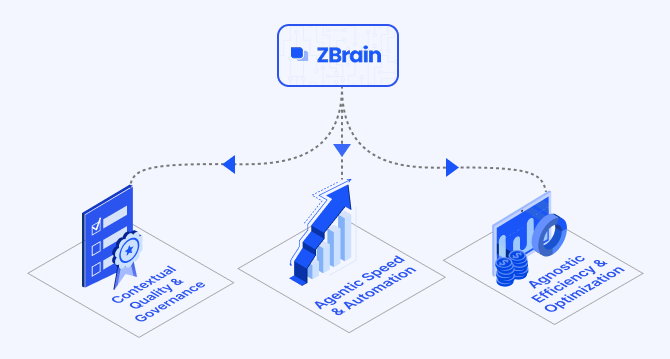
How ZBrain breaks the trade-offs in the AI iron triangle
ZBrain’s architecture directly challenges the conventional AI trade-off model—the notion that enhancing one aspect inevitably compromises another.
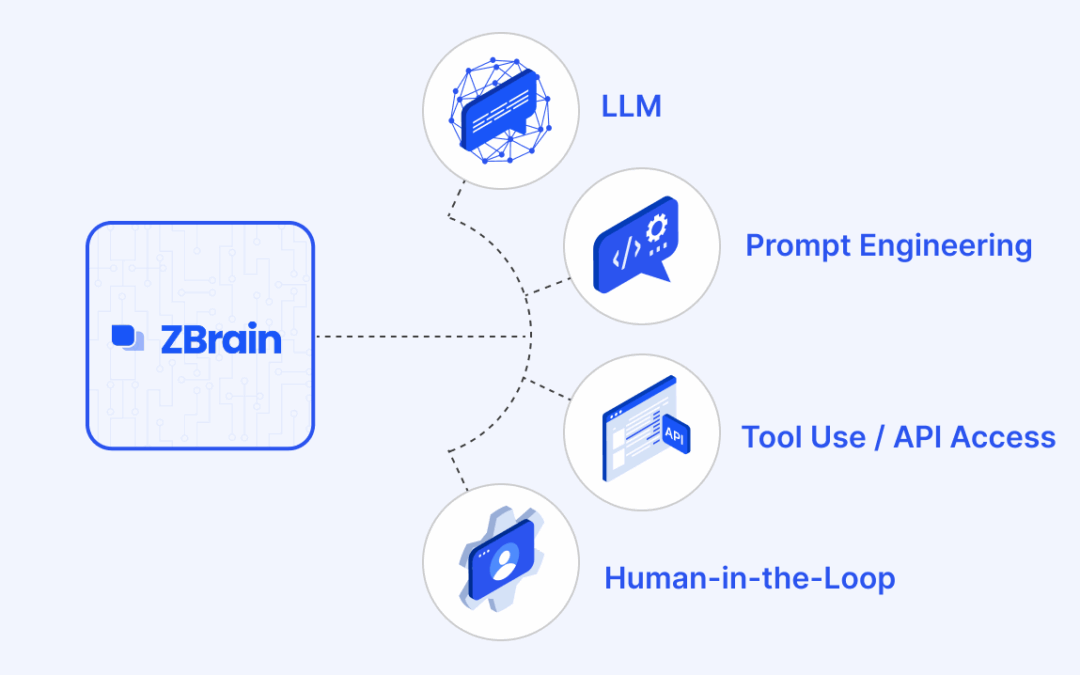
ZBrain Builder’s AI adaptive stack: Built to evolve intelligent systems with accuracy and scale
ZBrain Builder’s AI adaptive stack provides the foundation for a modular, intelligent infrastructure that empowers enterprises to evolve, integrate, and scale AI with confidence.
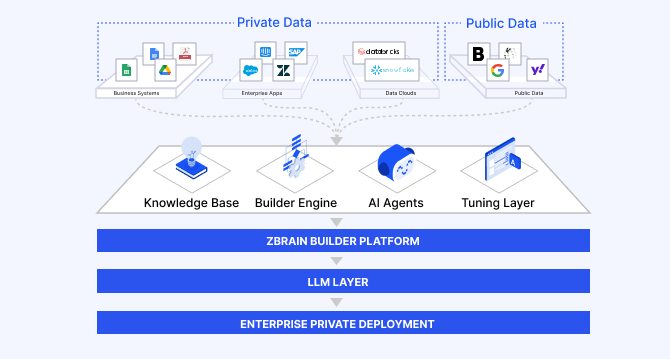
Automated AI workflows with ZBrain: Flows, LLM agents and orchestration patterns
ZBrain enables enterprises to design workflows that are intuitive for teams, efficient in execution, and adaptable to evolving business needs—transforming automation into a strategic advantage.
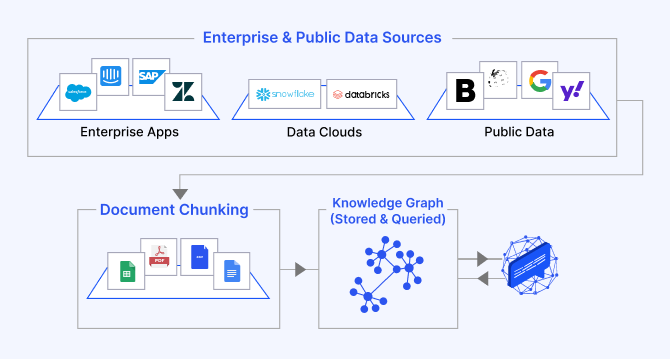
The role of knowledge graphs in building agentic AI systems: Architecture, reasoning, and ZBrain’s implementation
ZBrain Builder leverages knowledge graphs to improve contextual precision and enable reliable multi-hop reasoning in its agent responses.

ZBrain Builder: The agnostic agentic AI platform redefining enterprise AI orchestration
ZBrain Builder simplifies many aspects of AI development through its low-code interface and agnostic integration capabilities, maximizing its value depends on thoughtful planning across deployment, configuration, governance, and integration.

How ZBrain Builder accelerates enterprise delivery with low-code development
Low-code development and generative AI are two transformative forces that converge in ZBrain Builder to create a potent platform for enterprise innovation.















